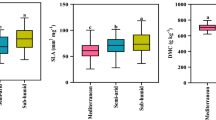Abstract
Callitriche intermedia shows a well-marked variation in its leaf form, dependent on whether the crown of the plant is submerged or floating at the surface of the water. When the crown is submerged, linear leaves are produced, up to 3 cm. in length and 1 mm. broad. When the crown reaches the surface, ovate leaves are produced, about 1.5 cm. long and 4 mm. broad at the widest point. A reversion to the linear type of leaf is produced if the crown is afterwards submerged.
This is a preview of subscription content, access via your institution
Access options
Subscribe to this journal
Receive 51 print issues and online access
$199.00 per year
only $3.90 per issue
Buy this article
- Purchase on Springer Link
- Instant access to full article PDF
Prices may be subject to local taxes which are calculated during checkout
Similar content being viewed by others
References
McCallum, W. B., Bot. Gaz., 34, 93 (1902).
Burns, G. P., Ann. Bot., 18, 579 (1904).
Author information
Authors and Affiliations
Rights and permissions
About this article
Cite this article
JONES, H. Variation in Leaf Form in Callitriche intermedia. Nature 170, 848–849 (1952). https://doi.org/10.1038/170848a0
Issue Date:
DOI: https://doi.org/10.1038/170848a0
This article is cited by
-
Die Bedeutung der Grenzflächenenergie für die Gestaltung der Zelle
Protoplasma (1956)
Comments
By submitting a comment you agree to abide by our Terms and Community Guidelines. If you find something abusive or that does not comply with our terms or guidelines please flag it as inappropriate.



